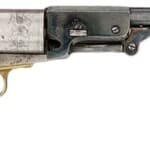
Introduction to the .222 Remington
The .222 Remington, introduced in 1950, is one of the most significant small-caliber centerfire rifle cartridges ever developed. Designed by Remington Arms, it became a revolutionary cartridge for varmint hunters, target shooters, and precision marksmen. As the first commercial rimless .22 centerfire cartridge in the United States, the .222 Remington set new standards for accuracy, efficiency, and performance.
Developed by Remington engineer Mike Walker, the cartridge was first chambered in the Remington Model 722 bolt-action rifle. It quickly gained a reputation for its outstanding precision and became the dominant cartridge in benchrest shooting for nearly two decades. Its design laid the groundwork for many future cartridges, including the .223 Remington and the .222 Remington Magnum.
Ballistics and Reloading Data
One of the hallmarks of the cartridge is its exceptional ballistic performance. It is a high-velocity, flat-shooting cartridge capable of outstanding accuracy. Here are typical ballistics for common bullet weights:
- 40-grain bullet: ~3,600-3,800 fps
- 50-grain bullet: ~3,200-3,500 fps
- 55-grain bullet: ~3,100-3,300 fps
Reloading Data
For reloaders, the cartridge offers flexibility in powder and bullet selection. Below are optimal load ranges for commonly used powders:
- For a 50-grain bullet: 21-24 grains of IMR4198
- For a 55-grain bullet: 20-23 grains of H4198
Other popular powders include Benchmark, H322, and Reloder 7, all of which provide excellent performance and accuracy. The case has a capacity of approximately 26-27 grains of water, making it slightly smaller than the .223 Remington but more efficient in combustion, contributing to its legendary accuracy.
Firearms Chambered for .222 Remington
The .222 Remington was widely adopted by rifle manufacturers around the world. Some of the most notable rifles chambered for this cartridge include:
- Remington Model 722 – The original rifle for which the .222 Remington was designed.
- Sako L46 – A high-quality European rifle with exceptional accuracy.
- Browning B78 – A single-shot falling-block rifle available in .222 Remington.
- Tikka T3 – A modern bolt-action rifle, particularly popular in Europe.
- Winchester Model 70 (Varmint Model) – A highly accurate rifle for precision shooting.
- Anschutz 1532 – A German-made rifle, often used in Europe for small-game hunting.
- Ruger M77 – A versatile American-made rifle chambered in .222 Remington.
- CZ 527 – A European bolt-action rifle with a reputation for precision.
Additionally, numerous custom rifles have been built around the cartridge, particularly for benchrest shooting, where the cartridge was dominant for many years.
Successors and Current Use
The .223 Remington, officially introduced in 1962, is often regarded as the direct successor to the .222 Remington. While both cartridges share similar ballistic characteristics, the .223 Remington has a slightly larger case capacity, allowing for increased velocity and energy. The .222 Remington Magnum, introduced in 1958, was another derivative but was largely overshadowed by the military adoption of the .223 Remington (5.56×45mm NATO).
Despite being surpassed in popularity, the .222 Remington remains a favorite among varmint hunters, benchrest shooters, and European hunters. It continues to be widely used in countries where military-derived cartridges like the .223 Remington are restricted. In Europe, it is a preferred choice for hunting roe deer, foxes, and other small to medium-sized game.
Why the .222 Remington Remains Relevant
Even though modern cartridges have taken the spotlight, the cartridge maintains a strong following for several key reasons:
- Exceptional Accuracy – The .222 Remington is renowned for its sub-MOA accuracy, making it a top choice for precision shooting.
- Mild Recoil – The cartridge produces minimal recoil, making it comfortable for extended shooting sessions.
- Long Neck Design – The extended neck allows for better bullet alignment and reduces throat erosion, prolonging barrel life.
- Efficiency – Its efficient case design ensures consistent powder burn, which contributes to outstanding shot-to-shot consistency.
- Handloading Potential – Reloaders can fine-tune the .222 Remington for extreme accuracy, often surpassing factory-loaded ammunition.
Conclusion
The .222 Remington is more than just a historical cartridge—it is a symbol of precision and ingenuity in firearms development. Its remarkable accuracy, mild recoil, and efficient design have cemented its status as one of the greatest small-caliber cartridges ever created. While it has been overshadowed by modern options like the .223 Remington, it remains a beloved choice among dedicated shooters and reloaders who appreciate its inherent accuracy and reliability.
From its dominance in benchrest shooting to its continued use in varmint hunting and European game hunting, the .222 Remington endures as a timeless classic. For those who value precision and tradition, this cartridge remains an outstanding choice that exemplifies the art of firearms engineering. Whether you're a competitive shooter, a seasoned hunter, or a collector of fine rifles, the .222 Remington deserves a place in your collection.
Read about this and other cartridges here:

If you know of any forums or sites that should be referenced on this listing, please let us know here.



